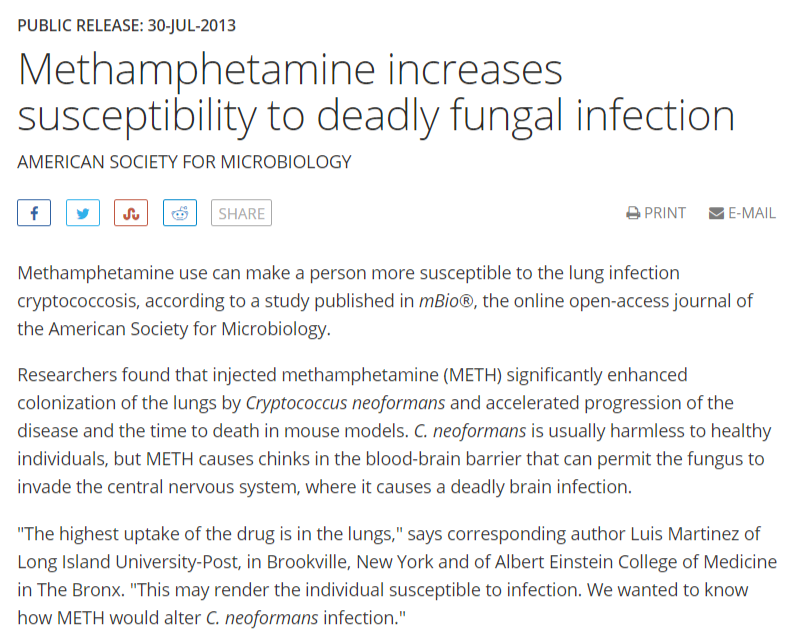This article details the science of how Methamphetamine (METH) addiction has been proven to cause serious fungal infections in users. These fungal infections that addicts develop that I contend are the main reason they engage in socially and morally unacceptable behavior and develop mental illness, which culminates into suicidal tendencies and nihilistic world views.
Often, just in a few short years, they go from looking like normal people to what we can call a demon-like appearance and behaviors. Hence, it makes them Meth Demons who seem to be hell-bent on destroying themselves and everyone around them.

My theory is that it is not just the METH that makes addicts crazy, but it is the fungi/molds that grow within their lungs and gastrointestinal tracts, which has been proven to be our second brain. Various studies have shown how quickly this weakens their immune system from ingesting a drug containing things like battery acid, fuels, antifreeze, and cold medicines combined with horrible eating habits, a severe deficiency of vitamins, a lack of sun, and a lack of sleep.
When you combine all these toxic ingredients with terrible health habits into a daily routine, studies show that METH addicts quickly develop serious fungal infections, and I believe it is these organisms that have turned parasitic within addicts that are manipulating them and controlling their actions via this second brain.
Please think about this.
In my experience, these addicts are humans. Many are good people who may be our sons and daughters who have ignorantly partaken in a deadly drug that can cause a severe medical condition that can destroy their health and steal their personalities and ultimately ruin their lives.
Who would tolerate and still use a drug like METH that destroys how we look, our relationships, how we think, feel, and act and eventually lead to our death?

Are the people who use these drugs still “in control of their bodies and minds” or is their drug use resulting in a “pathogen” that is hell-bent on mind-controlling their victims?
Just like they have done to other animals and insects throughout the world as I describe in my articles, “Lord of the Flies: Fungi controls fly’s mind as it preys and infects other flies,” and “Parasitic mold that controls cicadas mind and forces them to infect other insects.”
Before I began sharing my research, I would like you to think about some questions that I believe will give you context to my theory as you read further;
* Did you know that chronic METH use severely increases the chances of a systemic fungal infection in the lungs and brains of users?
* Did you know that both METH and molds/fungi cause biochemical, behavioral, and physiological abnormalities and psychosis?
* Did you know that both METH and molds/fungi can lead to long-term deterioration of attention, memory, and judgment?
* Did you know that both METH addicts and molds/fungi love sugar?
HOW METHAMPHETAMINE USE CAUSES SYSTEMIC FUNGAL INFECTIONS
In the United States of America, Methamphetamine (METH) addiction is one of the worst threats to our society because it adversely changes people’s behavior, making them more prone to crime and carriers of and transporters of various infectious diseases. One of these diseases that METH addicts are highly susceptible to developing and influencing their pathogenic behavior that I would like to bring to your attention is a systemic fungal infection.
It is essential to understand that METH use destroys your immune system and make addicts much more susceptible to infection. Several studies have been done over the last decade, showing the severe impact of methamphetamine on infection and immunity. A 2015 study had shown that as a result of drug use, our bodies create chemical defenses, which increases the pro-inflammatory responses, and the induction of oxidative stress pathways.
This causes significant neurotoxicities to arise, increasing the risk for acquiring transmissible microbes and other opportunistic infections such as systemic fungal infections; this research has been documented worldwide (Plankey et al., 2007; Volkow et al., 2007; Ye et al., 2008; Sutcliffe et al., 2009; Parry et al., 2011; Borders et al., 2013; Eugenin et al., 2013; Heninger and Collins, 2013; Khan et al., 2013; Stahlman et al., 2013; Liao et al., 2014).

According to the researchers in the study;
METH abrogates normal macrophage function, resulting in accelerated disease in murine histoplasmosis (Martinez et al., 2009). METH decreases phagocytosis and killing of H. capsulatum by primary macrophages. METH exposed H. capsulatum-infected mice have increased fungal burdens, increased pulmonary inflammation, and reduced survival.
METH exposure results in cytokine dysregulation, aberrant processing of yeasts within macrophages, and immobilization of MAC-1 receptors on the macrophage surface. Additionally, METH inhibits T cell proliferation and alters antibody production, both important components of adaptive immunity. Hence, it is established that METH alters the immune system of a mammalian host, resulting in enhanced disease (Martinez et al., 2009). (1)
It has been proven by science through various studies that METH has diverse effects on a person’s immunity, and it also stimulates fungal adhesion and biofilm formation in the lungs, which causes dissemination of the fungus from the respiratory tract into the brain. Meaning it provides the perfect environment in your body for molds/fungi to grow, reproduce, and become permanent residents in our lungs and brain.
This is when I believe the fungi become pathogenic and can seriously manipulate an addict’s mind to do its bidding like they have been proven to do in other insects.
It turns humans into walking and talking fungal parasites – AKA Demons!
To document these transformations in their appearance and in hopes to scare other people from using this demon drug, the Faces of Meth campaign was launched in 2004. Their goal was to show before and after pictures of users side by side, which proves the devastation that meth use causes to addicts – sometimes over the course of a few months.
According to a study done in 2013, researchers discovered that METH use has profound implications on tissue homeostasis and the host’s capacity to respond to invading pathogens such as Cryptococcus neoformans (C. neoformans). (2) Meaning, that people who use METH are weakened to the point that they do not have a healthy immune system which allows pathogens such as the microorganism known as fungi or molds in English that causes, or can cause, disease and damage in its host.
The researchers call this an “enhanced fungal invasion.”
According to the lead researcher, Luis Martinez of Long Island University-Post, in Brookville, New York and of Albert Einstein College of Medicine in The Bronx;
Martinez says this greater ability to cause disease in the lung may be due in part to simple electrical attraction.
Their analysis shows that METH imparts a greater negative charge on the surface of the fungal cells, possibly lending them a greater attraction to the surface of the lung and an enhanced ability to form a biofilm that can protect its members from attack by the immune system. The fungus also releases more of its capsular polysaccharide in METH-treated mice, which can help the organism colonize and persist in the lung.
He commented, “When the organism senses the drug, it basically modifies the polysaccharide in the capsule. This might be an explanation for the pathogenicity of the organism in the presence of the drug, but it also tells you how the organism senses the environment and that it will modify the way that it causes disease.”
But the fungus doesn’t stop in the lungs. “The drug stimulates colonization and biofilm formation in the lungs of these animals,” says Martinez. “And this will follow to dissemination to the central nervous system by the fungus,” Martinez says.
The conclusion of the study stated;
“METH promotes C. neoformans colonization of the lungs upon infection and subsequent biofilm formation. Our findings suggest that C. neoformans biofilms may act as a fungal reservoir, shielding single cells from phagocytic cells, which can later disseminate, especially to the CNS. Moreover, the drug causes profound defects in the integrity of the Blood-Brain-Barrier BBB in vivo, increasing permeability, and facilitating the transmigration of C. neoformans to the CNS.
METH-induced alterations to the molecules responsible for maintaining the integrity of the BBB provide an explanation for the susceptibility of a METH abuser to brain infection by HIV and other pathogens. Broadly, METH has diverse and pronounced detrimental effects on host immunity that can also enhance pathogen persistence and proliferation.”
I would like to point out that METH is a drug that acts upon the central nervous system and chronic meth abuse causes detrimental effects on host immunity, which can lead to the fungi/molds proliferating the lungs and the blood brain barrier through the central nervous system.
It is akin to the fungi taking a bullet train to your brain via the central nervous system.
In some people, the parasite-host manipulation from the GI Tract can start happening immediately or within days/weeks causing them to develop psychosis or go insane i.e.: parasite-controlled humans.
METH also causes the massive release of the neurotransmitters like dopamine, norepinephrine, and serotonin, and blocks their reuptake, leading to long-term deterioration of attention, memory, and judgment. (Downes and Whyte, 2005; Collins et al., 2014). That may be one reason why users make such poor choices repeatedly because they have forgotten how to be human, and the moral codes that govern our societies are swapped by the moral codes of the fungal parasite, of which there seem to be none.
Hence, you will know them by their fruits or, more appropriately, their moldy and decaying fruits.
Along with neuropsychiatric deficits, methamphetamine abusers suffer from mental illnesses such as anxiety, depression, and psychosis being the most commonly reported.
Now, let me turn your attention to the fact that the toxins produced by some fungi/molds are neurotoxins that are poisonous or destructive to brain and nerve tissue, which causes a condition known as neurotoxicity. The term neurotoxicity refers to damage to the brain or peripheral nervous system caused by exposure to toxins and myconeurotoxicity when a person is exposed to mold toxins, which I believe is exactly happening.
When mold mycotoxins cause neurotoxicity, it is called myconeurotoxicity, which refers to any adverse effects of exposure to mycotoxins or byproducts of primary and secondary mold metabolism, including volatile organic compounds (VOCs) on the structural or functional integrity of the developing or adult nervous system. Neuromycotoxic effects may involve a spectrum of biochemical, morphological, behavioral, and physiological abnormalities whose onset can vary from immediate to delayed actions, following exposure to mycotoxins. The duration of effects may be transient or persistent and result in disability in some individuals, while some may have life-threatening consequences. (3)
A November 2015 study of mice titled “Mold inhalation, brain inflammation, and behavioral dysfunction” was developed by researchers to show a mouse model to determine how mold exposure can lead to neurobehavioral dysfunction. The researchers had formed a hypothesis that mold inhalation, like a bacterial infection, activates an innate immune response triggering microglial activation with resultant behavioral dysfunction.
Here is an excerpt from the study:
“Deficits in contextual memory were correlated with numbers of amoeboid microglia and microglial size in the dorsomedial dentate gyrus. Spore inhalation increased the numbers of cells in the hippocampus expressing the proinflammatory cytokine interleukin-1beta (IL-1beta). Increased numbers of cells expressing IL-1beta in hippocampal CA1 were positively correlated with spatial memory deficits and increased fear.
Mold exposure also affected two of the three stages of neurogenesis. Inhalation of EX spores decreased numbers of immature new neurons in the dorsomedial hippocampus expressing doublecortin, while IN treatment decreased numbers of adult-born BrdU-labeled neurons that matured and expressed NeuN. Our data suggest that respiratory exposure to any mold, not just the particularly toxic ones like Stachybotrys, may be capable of causing brain inflammation, cognitive deficits, and emotional problems.” (4)
Immune system disorders and abnormal natural killer cell (NKC) activity was found in patients with chronic toxigenic mold exposure in a 2003 study. The major symptoms reported were headache, general debilitating pains, nose bleeding, fevers with body temperatures up to 40 degrees C (104 degrees F), cough, memory loss, depression, mood swings, sleep disturbances, anxiety, chronic fatigue, vertigo/dizziness, and in some cases, seizures.
The researchers found that the patient’s sleep could be disturbed by mycotoxins and exerted some rigorous effects on the circadian rhythmic processes resulting in sleep deprivation. Depression, psychological stress, tissue injuries, malignancies, carcinogenesis, chronic fatigue syndrome, and experimental allergic encephalomyelitis could be induced at very low physiological concentrations by mycotoxin-induced NKC activity.
The researchers concluded that chronic exposures to toxigenic mold could lead to abnormal NKC activity with a wide range of neurological consequences, some of which were headache, general debilitating pains, fever, cough, memory loss, depression, mood swings, sleep disturbances, anxiety, chronic fatigue, and seizures.
This research correlates with other studies that have focused on mold exposure, brain changes, and neuropsychological problems such as mild traumatic brain injury, dysregulation of emotions, decreased cognitive functioning, short-term memory loss, executive function/judgment, concentration, and hand/eye coordination.
It is important that you understand my theory that it is not the methamphetamine that is causing the mental illness and psychosis, but that it weakens the users’ immune system, leading to a systemic fungal infection, additional infections. For example, it is not just the fungus, Cryptococcus neoformans (C. neoformans) that people need to worry about but other fungi can cause infection, illness, disease, and death in addicts.
METH CAUSES CANDIDA INFECTIONS AND CANDIDA INFECTION CAUSE MENTAL ILLNESS, ITCHING SYSTEMS, AND MEMORY LOSS
Candidemia, a bloodstream infection caused by Candida species and is prevalent amongst IV Drug users of METH. Candidemia is typically considered a health care-associated infection, but injection drug use (IDU) has emerged as an increasingly common condition related to candidemia. Among 203 candidemia cases in the Denver metropolitan area during May 2017–September 2018, 11% of the cases were IV drug users and of which 73% reported using METH, according to research published by the CDC. (5)
Studies have shown that METH facilitates intracellular replication and inhibits intracellular killing of Candida albicans and Cryptococcus neoformans. (6)
Candida is a yeast-like fungus naturally found in small amounts in human digestive tracts, but drugs enhance its overgrowth like METH with its chronic use, poor diet, excess sugar intake, and lack of sleep. Users often report itching sensations and scratch their skin, creating sores sometimes all over their bodies and faces. Users have even made claims of bugs, worms, and or flies crawling underneath their skin.
What is interesting is that Candida infections cause burning, itching symptoms, thrush (rashes in the throat or mouth), and sexually transmittable genital yeast infections in men and women.
Candida infections are linked to mental illness and are more common among those with memory loss.
The same mental issues that chronic Meth users suffer from.
For example, in a 2016 study published in Science Daily, both men and women with schizophrenia or bipolar disorder who tested positive for Candida performed worse on a standard memory test than people with the same disorders who had no evidence of past infection. According to the lead researcher, Emily Severance, Ph.D., assistant professor of pediatrics and member of the Stanley Division of Developmental Neurovirology at the Johns Hopkins University School of Medicine;
“Although we cannot demonstrate a direct link between Candida infection and physiological brain processes, our data show that some factor associated with Candida infection, and possibly the organism itself, plays a role in affecting the memory of women with schizophrenia and bipolar disorder, and this is an avenue that needs to be further explored,” says Severance.
“Because Candida is a natural component of the human body microbiome, yeast overgrowth or infection in the digestive tract, for example, may disrupt the gut-brain axis.
This disruption, in conjunction with an abnormally functioning immune system, could collectively disturb those brain processes that are important for memory.”
“However, most Candida infections can be treated in their early stages, and clinicians should make it a point to look out for these infections in their patients with mental illness.” She adds that Candida infections can also be prevented by decreased sugar intake and other dietary modifications, avoidance of unnecessary antibiotics, and improvement of hygiene. (7)
SOURCES:
1. Impact of methamphetamine on infection and immunity
2. Methamphetamine Enhances Cryptococcus neoformans Pulmonary Infection and Dissemination to the Brain
3. The validity of the environmental neurotoxic effects of toxigenic molds and mycotoxins
4. Mold inhalation, brain inflammation, and behavioral dysfunction
6. Methamphetamine Inhibits Antigen Processing, Presentation, and Phagocytosis –
7. Yeast infection linked to mental illness

Moe is the founder of GnosticWarrior.com. He is a father, husband, author, martial arts black belt, and an expert in Gnosticism, the occult, and esotericism.









I’ll Start off by saying I was a meth addict for five years, sober for four, and just recently started back A couple of months ago. As far as the pictures of the faces of Meth, that was from The stuff that was being cooked years ago. Now it’s almost impossible to get the materials to make that kind that causes holes in your body. Now as far as the fungal infection goes, anybody reading this article who knows how meth is actually made Will find it rather freaky but also eye-opening at the same time. Meth nowadays, also known as ice, is actually a fungus. I know it sounds crazy, but when you’ve seen it be made, you understand it is a living organism. The Meth nowadays is not cooked from chemicals like back in the old days. It is actually grown, just like you would grow mushrooms from spores, it is grown from chemicals but nevertheless it is grown. Is formed and grows as a living organism otherwise it would not grow. So in my honest opinion I do believe the meth nowadays is causing fungal infections, and not just causing the user to be more susceptible to it. When you ingest a fungus, you’re bound to have a fungus in you. I know for the five years that I used it Towards the end I got really bad psoriasis on my chest and I was a heavy smoker of ice. This is the first time in my life I’ve ever developed psoriasis. When I got sober it immediately went away. Yes I do believe the meth is what caused it. So if you do a little research and you dig deep, you will find how it is actually made nowadays. And when you do either before or after you’ve read this article you will make the connection. I appreciate you reading.
Really need to share my experience what we meet have combined will turn the world upside down and I am a very informed born again believer. My email [email protected]
Hi. I am curious at why you came up with this concept? To me it makes a lot of sense. I am dealing with a wicked fungus battle after living in a apartment with mold. I never got the apartment tested but once I found it I got out of there. I lived there for almost 4 years. I am a different person than I was living there but I’m still fighting candida. It’s in my sinuses so the treatment im doing for my gut which is working isn’t touching my sinuses. I have done meth off and on in my life for 18 years.I switch between adderall and meth. I do not and have never looked like the demons you describe. I still have all my teeth and they are in great condition. I don’t look my age. But I have always self medicated with the meth so i have been very adamant on proper nutrition and water and sleep. I have narcolepsy. I also have never injected it. I always saw “slammers” as shells of people. They move different. They act different. At one point in my youth i would get my meth from a slammer because I knew they always had cleaner stuff because they have to be able to shoot it in their arm. But I would spend a little time as possible around him. So I 100% agree with you they are being controlled by something else. Like 5 years ago I had a friend that treated a dog for mange and the mites jumped species because she had shingles at the time. I ended up getting infested with the scabies because I was working in a water damaged building that had bad mold and my home had mold so my immune system was in the gutter. I have the mold gene that makes my body not acknowledge spores as a threat. Before I figured out I had the scabies I just thought I had candida. I would eat dinner go to bed and then have dreams about sweets or carbs and wake up 2 hours later starving and compulsively eat something sweet and go back to sleep. This would repeat all night. I swore whatever was inside me had figured out how to control my dreams to make me eat sugar. So I have felt the fungus trying to take control. A month or so after this I realized I had scabies. This was hell. I lost my job because they thought I was losing my mind. Which thank god I would have died if I stayed there. I told my friend we had to leave my apt because I’m not ruining my home. I have a terrible bug phobia and im allergic to scabies so it was super hard on me mentally. We bounced around staying in the hotels and casinos in the area for a while so we had a clean place to sleep every night. I started smoking meth at this time just to be able to cope with what was happening to me. I noticed the scabies liked the meth. I even said this to my friend and she said she felt the same way. She would keep infected me because she wouldn’t listen and didn’t seem to see them as a problem like I did. She also had been years in smoking meth. I believe she had fungus controlling her for the most part. I went home after 2 months long enough for things to die in my home. I was vacuuming with my roommates vacuum and did the whole house. And then for some reason I decided to vacuum this wall that had a few holes in it from hanging stuff. And instantly after that I felt like I had spread mold all over my house. My friend came over and found me having a straight panic attack in my room. I don’t know why I thought mold then but I was 100% right looking back. I thought I had developed psychosis and I didn’t know up from down. I was treating myself with a bunch of poisons for the bugs because the doctors here just told me I was crazy and gave me neosporin. I know I had some kind of bacteria involved in this battle as well because I had black wounds that wouldnt heal. I had some leftover antibiotics and they helped. I went to burning man. The black rock desert is all bentonite clay. It kills everything. That desert has saved my life so many times from a handful of bad things. And everytime I’m out there I feel like I have the most mental clarity. I used to say I go to deal with myself because it’s the only place I have to focus on me and I have to fight the desert to survive because it feels like it’s killing me. It’s just killing off the fungus and bacteria. Sometimes I herx. I just learned what that was. I came back from the burn that year and decided I had broken my brain with drugs and got sober for 8 months. I still took my prescription for adderall. I was a different person during that time. I was living in the mold Apt and just going to work everyday. I didn’t feel like me but I just thought that was because I was not partying. I go to EDC in may. Tell myself I’m allowed to take meth since I’m on vacation. I weigh it out and put it in pills. Had a great weekend taking mdma and dancing all night long. When I came home I could tell I was more like me again. Just the way my room looked and how I had everything set up I just thought wow I was depressed. I don’t even know how I could live like this. Then until quarantine I would only take meth on the weekend and adderall during the week. I stayed me. Being trapped in my apt for quarantine poisoned me with mold again. I started doing weird stuff. 7months later my health was deteriorating so bad between work and home I started taking meth daily again for 7 months. I was able to get out of the mold but it was eating my brain. My adhd symptoms got so bad. I felt like I was trapped in time and just couldnt think. When my boyfriend found the bad air filter and pulled it out in front of me I lost the ability to talk. I had to go sit outside for like 10 minutes before I could say anything. Getting out of that place has made a lot of that better. I quit take the meth in July because i felt like the toxic load in my body was too much. Over the next 2 months with just adderall my digestive health went to all hell and the candida took over. Went to the desert and had the worst hexerheim reaction ever because I went in a trailer. The lymph nodes on my ankle were the size of golf balls. I had a moment out there after I had eaten some mushroom where I told my boyfriend I think we are all actually fungus. Like consciousness is fungus. Human bodies are just something we know how to hijack. That’s why we are all connected. After I came home I came across info on how to fight candida and realized everything I go do at the desert kills them. So I started doing a mold detox. I’m 3 months in and I feel so much better. I just need to figure out how to remove the candida in my sinuses because it’s not responding to treatment. Interestingly my boyfriend had me watch a documentary he found because he said it talked about my fungus hypothesis. And yeah I guess fungus was the reason life started on our planet. And humans back then would eat psychedelic mushrooms before hunts to help them socialize with others and hunt. From my personal experience I feel psilocybin mushroom have helped me keep my brain healthy and helped me heal from trauma and maybe helped keep me from becoming one of those demons.
HOLY SHIT.
That’s A LOT of data.
But thanks for sharing.
Super interesting.
JUST. WOW.
Would be interested to know if/how you took back control.
Despite this “fungus” I believe as Creators we are all capable.
Don’t EVER keep up.
Free will cannot be reckoned with, I know this in my gut.
These archonic forces are powerless over free will and intention.
Thanks again for sharing, and if you come back please let us know how you are doing.